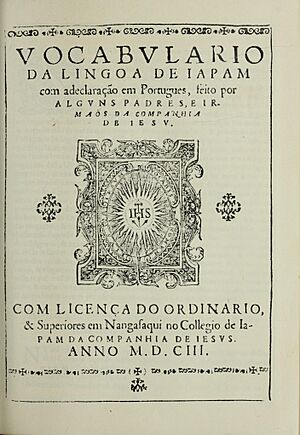Nippo Jisho facts for kids

|
|
| Original title | Vocabulario da lingoa de Iapam |
|---|---|
| Country | Japan |
| Language | Japanese and Portuguese |
|
Publication date
|
1603 |
|
Original text
|
Vocabulario da lingoa de Iapam at Gallica |
The Nippo Jisho (also called Vocabulario da Lingoa de Iapam) is a special dictionary. It was the very first dictionary to translate Japanese words into a European language. This language was Portuguese.
Jesuit missionaries created this dictionary. They published it in Nagasaki, Japan, in 1603. It has over 32,000 Japanese words. Each word is explained in Portuguese. The original book used only the Latin alphabet. It did not use Japanese characters like kanji or kana.
Later, other versions of the dictionary were made. Some were printed again in Japan in the 1960s and 1970s. There was also a Spanish translation in 1630. A French version came out in 1869. In 1980, a Japanese translation was published. An English translation was being worked on in 2023.
Contents
How the Dictionary Was Made
The Society of Jesus, also known as the Jesuits, worked on this dictionary. Japanese people also helped them. They spent many years putting it together.
The main goal was to help Christian missionaries. They needed to learn Japanese for their work. A Portuguese priest named João Rodrigues was likely the main person in charge. He was known for being very good at Japanese. He had already written other books about the Japanese language.
What's Inside the Nippo Jisho?
The dictionary has about 32,000 words. They are listed in alphabetical order. Each Japanese word is written using the Latin alphabet. Then, its meaning is explained in Portuguese.
The main purpose was to teach people how to speak Japanese. The dictionary also points out different things about words. For example, it shows if a word is from a certain region. It also notes if a word is used in writing or speaking. It even tells you if a word is for women, children, or is considered polite or rude.
Many words in the Nippo Jisho were written down for the first time. The way words were spelled helps us understand 16th-century Japanese. This is called Late Middle Japanese. It was different from modern Japanese. This dictionary gives linguists important clues. They can learn how the Japanese language has changed over time. The dictionary also shares facts about how words sounded. It includes popular sayings and customs from that period.
Because it's so old and important, other Japanese dictionaries often use it. For example, the huge Nihon Kokugo Daijiten dictionary uses the Nippo Jisho as a source.
Examples of Words and Spelling
The people who made the Nippo Jisho created a special way to write Japanese words. They used Portuguese Roman letters. This system helps us see how Japanese was spoken in the 16th century.
Here is an example from a review of the dictionary:
In this example, the modern sound ki was written as 'qi'. The sound ku was written as 'cu'. Also, the sounds ha, hi, fu, he, and ho were written as 'fa', 'fi', 'fu', 'fe', and 'fo'. This shows how pronunciation has changed.
Other interesting examples from the dictionary:
- The name of the country, 日本, was written nifon, nippon, and jippon.
- The capital city, 京都 (today's Kyoto), was written cami. This probably meant "upper."
- Kyūshū was written as ximo. This probably meant "lower."
- The phrase for "the first call of birds in spring" was fatçu coye. Today it's "hatsu koe" 初声.
- A spring warbler was faru uguysu. Today it's "haru uguisu" 春鶯.
- The word 侍 (samurai) meant a noble person. The word 武士 (bushi) meant a warrior.
- The word 進退 (shintai today) was listed as shindai.
- The word 抜群 (batsugun today) was bakkun.
- The word rorirori meant "unsettled from fright."
Where Are the Original Copies?
Only four copies of the original 1603 dictionary still exist. Three of them are in Europe.
- One copy is at the Bodleian Library in Oxford, England.
- Another is at the Bibliothèque nationale de France in Paris, France. You can even see it online!
- The third is at the Public Library of Évora in Portugal.
The fourth copy is in South America. It is at the National Library of Brazil. This copy once belonged to Empress Teresa Cristina. In 2020, a new copy of this Brazilian version was printed.
See also
- Arte da Lingoa de Iapam
- Rakuyōshū

